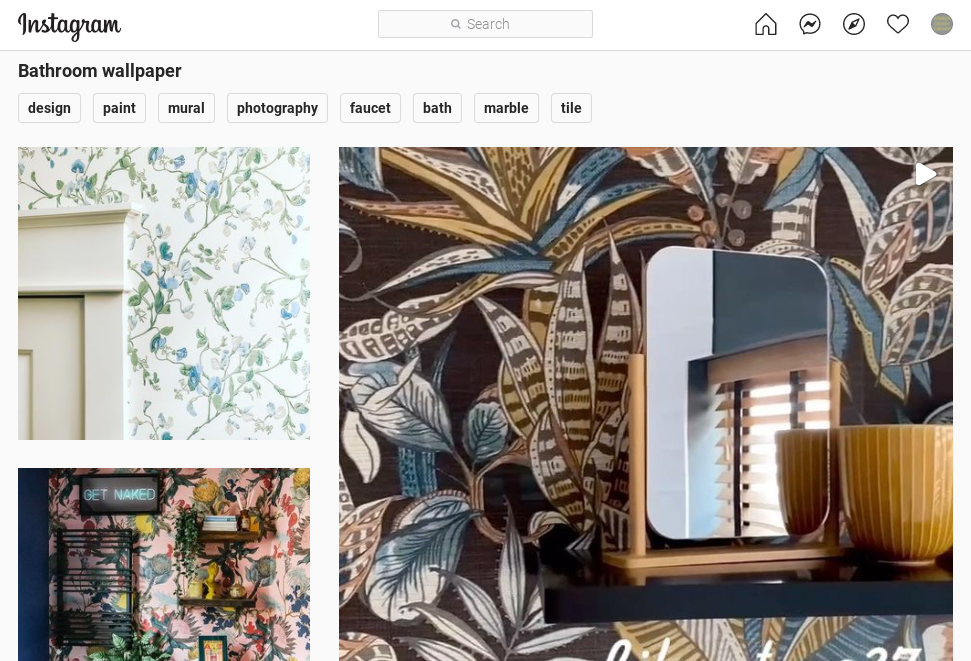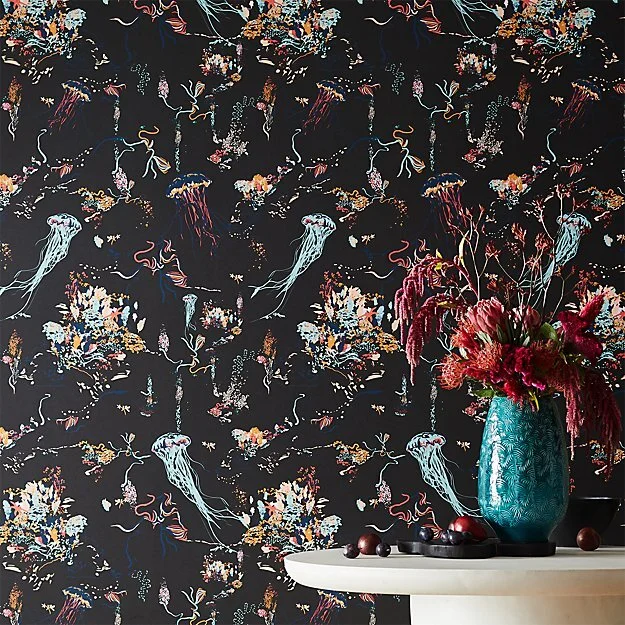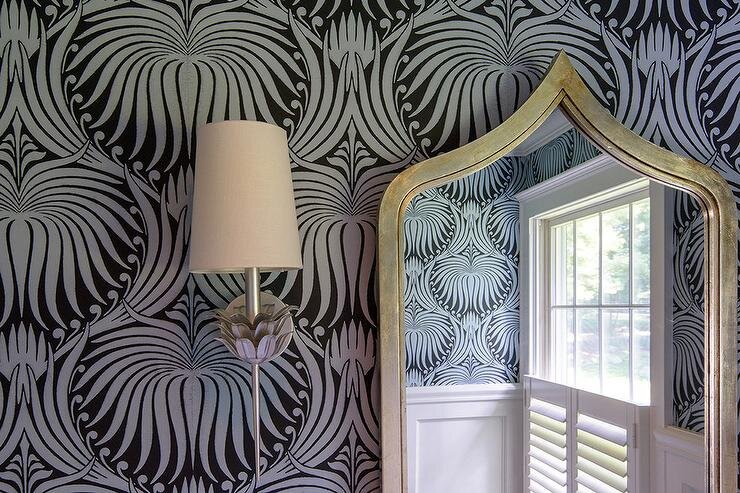Wallpaper in the Bathroom - Pros, Cons & How to do it the Right Way
Wallpaper in the bathroom - If you search Instagram or Pinterest for “bathroom wallpaper”, you are going to find some pretty wild & amazing bathroom designs.
Bold patterns, bold prints, bold colors. But when it comes time to renovate your bathroom, how willing are you to walk on the wild side with wallpaper?
A quick coat of white paint is so much simpler, cheaper & definitely safer.
Plus, won’t wallpaper just get ruined by all that steamy shower humidity?
For today’s article, we convinced interior designer Angela Amlani from Decor Answer to help us with this article about putting up wallpaper in YOUR bathroom…should you do it & how can you do it right? Here’s what Angela had to say:
Should You Put Wallpaper in Your Bathroom?
When it comes to using wallpaper in your bathroom, there are a lot of pros & cons
Pros
Cost when compared to tile & stone
Fun patterns, bold colors & shapes
Wide variety of design options
Cons
Moisture
Lingering humidity - Bathroom humidity increases when you have a bath or shower, but that humidity shouldn’t linger for more than a few minutes. A properly working bathroom exhaust fan should reduce humidity from lingering. If it doesn’t, and your bathroom remains humid, you may develop a problem with mold & mildew.
Moisture can cause wallpaper to peel.
Traditional cellulose-based wallpaper isn’t designed to fend off the water droplets and steam kicked up regularly by the tub and/or shower. Moisture and humidity can penetrate, weaken the paste and cause it to fail. If this happens, the wallpaper will curl up from the seams between pieces or at the baseboards.
Mold thrives behind wet wallpaper.
Moisture trapped behind wet bathroom wallpaper can cause mold growth. Molds found behind wallpaper, such as Aureobasidium, can cause skin irritation or infections, while toxigenic molds such as Fusarium can cause abscesses & infections. And because the mold is growing behind the wallpaper, you won’t even know it’s happening.
STAINS & WATER DAMAGE
Water from sink splashes & plumbing leaks
Stains - toothpaste, shaving cream, etc
Douglas Robb - Interior Design Toronto: Any PROS that you would add to my list?
Angela Amlani - Decor Answer:
In a bathroom, wallpaper can actually last longer than paint. Paint easily wears away and can get damaged in messy and high traffic environments. From experience, if the paper has been properly installed, it will typically last three times longer than paint.
Another advantage in an area where you are using aerosols and hairsprays is that wallpaper can be scrubbed with a sponge and a mild detergent.
Although the cost of wallpaper can be two three times higher than paint, you get a much more dramatic result.
Douglas Robb - Interior Design Toronto: Any CONS that you would add to my list?
Angela Amlani - Decor Answer:
One downside is the cost of the paper. It is an investment. Paint is a more a cost-effective finish as opposed to wallpaper. The wallpaper that you select is something that you have to love. If you get tired of the pattern or the colour, there is more involved in changing it as opposed to paint.
The seams of wallpaper can lift over time, so there is some maintenance involved. This could involve replacing or resealing the seams in order to prolong the lifespan of the paper in humid areas.
Most of the wallpapers for wet areas are vinyl or fibreglass yarn. The first generation of vinyl papers contained VOC’s, phthalates, and bromine, just to name a few of the toxins - all toxic and unsafe. Today the manufacturers are working towards producing healthier options.
When looking into wallcoverings, be sure to look for:
low VOC and non-toxic options. Look for terms such as phthalate-free and non-brominated flame retardants.
water-based inks & recycled content.
sustainability standards, including NSP/ANSI 342 and the CE Mark
How to Properly Install Wallpaper in Your Bathroom
Proper installation and maintenance can reduce wallpaper woes.
Choose the “right” kind of wallpaper
Vinyl, fabric-backed vinyl, or paper-backed vinyl wallpapers can be scrubbed, stripped and are resistant to moisture and humidity.
However, vinyl selection can be limited. There is also an environmental concern with vinyl.
Splash-proof or water-resistant wallpaper claim to resist humidity & water splashes
Wall Prep
Apply a mold-proof wallpaper primer to the wall before wallpaper paste. This will help create a smooth surface for the wallpaper to adhere to while keeping the wall from absorbing the paste.
Choose the right wallpaper paste
Use mold-proof wallpaper paste, and apply extra paste underneath any areas of wallpaper near a shower.
Protect the wallpaper
If you want to use a non-vinyl wallpaper, apply a clear acrylic varnish (Decorators varnish) over the installed wallpaper to boost its resistance to moisture and heat. This will also lessen the chances of the wallpaper becoming permanently stained.
Reduce bathroom humidity
Install a high-powered bathroom fan and run it while showers or tubs are in use to keep water vapor from settling on and seeping into wallpaper.
Leave the bathroom door and/or windows open during and after bathing to let the steam escape whenever possible.
Maintenance
Dust your wallpaper on a weekly or biweekly basis.
Wash the walls regularly as per the manufacturer’s recommendations.
DIY vs hiring a pro
Materials & tools
Know-how
The increased cost of hiring a professional
Douglas Robb - Interior Design Toronto: What are your thoughts on water-resistant or splash-proof wallpaper? Is it as good as advertised?
Angela Amlani - Decor Answer: Definitely consider these wallpapers. They are a good option for all sorts of bathrooms. They can be used in powder rooms, bathrooms and can elevate the style of the bathroom and be functional all at the same time.
Installation is crucial to a successful water-resistant wallpaper. There are hand-painted or delicate papers that would not succeed unless you use the proper substrate and sealer even though these papers may be advertised as being water-resistant.
Vinyl paper is what is most commonly used in bathrooms as they are naturally water-resistant and splash-proof. These papers have come a long way in recent years as they are more environmentally sound and manufacturers can create many more interesting and amazing patterns as compared to the options that previously existed for vinyl.
Also, now there are papers that are made from fiberglass yarn which can actually be applied to shower walls instead of tiles. These papers are absolutely stunning as they are typically murals and can be quite dramatic. Below are some examples for you to look at.
Douglas Robb - Interior Design Toronto: What about using a matte/flat finish varnish over “normal” wallpaper? Do you have experience with that? Any comments?
Angela Amlani - Decor Answer: Always follow the manufacturer’s instructions and use what is recommended. I leave that to the professionals! Having said that, the varnishes come in different finishes and if not applied as directed they can look streaky or be visible. A matte finish is the best as it gives you the protection that is needed without extra shine which can distract from the beauty of the paper.
Douglas Robb - Interior Design Toronto: As a designer, I’m going to assume that you would recommend hiring a professional wallpaper installer vs DIY. Do you have any horror-stories or advice for someone considering wallpapering their own bathroom.
Angela Amlani - Decor Answer: Funny you should ask. For traditional wallpaper installation, I always use a professional wallpaper installer. However, a recent trend is for homeowners to install peel and stick products by themselves in simple installations. The newer peel and stick products are easy to work with, as the paper can be easily repositioned as opposed to pasted wallpaper which dries within a certain window of time. With peel and stick, you can take as long as is needed and the paper can be removed from the wall and repositioned as many times as required.
If you are going to install wallpaper yourself, It takes a lot of planning. You must accurately calculate the number of rolls keeping in mind where to start each roll based upon the repeat pattern of the wallpaper. A larger scale print will waste more paper than a smaller scale print.
One unfortunate story is that I had a client who had a previous non-professional install an ostrich textured wallpaper. The paper was quite beautiful but due to an improper installation, gaps existed between the lengths of the paper and as a result the wallpaper began to peel away from the wall. The result is that the wallpaper needed to be replaced within a year. When in doubt, always hire an expert!
Design Options
It’s not just the technical aspects of wallpaper that we need to consider. Choosing between paint & wallpaper in your bathroom includes a bunch of design considerations.
Colour
Pattern
Texture & materials - shiny paint vs a grasscloth wallpaper
Mood - serious vs fun, quiet vs loud, etc
Douglas Robb - Interior Design Toronto: All the articles on bathroom wallpaper recommended vinyl and/or splash-proof wallpaper for its moisture resistance. What are your thoughts on vinyl and/or splash-proof wallpaper from a design perspective? How do vinyl wallpapers compare to “paper” wallpapers?
Angela Amlani - Decor Answer: As a designer, it is very important to always consider form and function. Yes, it can look beautiful but it also needs to be durable and it needs to last! Be sure that the wallpaper selected is suitable, appropriate and properly installed.
Douglas Robb - Interior Design Toronto: What about peel & stick wallpaper? It’s having a real design moment right now as technological improvements have lowered the price point while improving the quality & design options. Is peel & stick wallpaper a good choice for bathrooms?
Angela Amlani - Decor Answer: In the section on installation, I highlighted the growing trend of DIY peel and stick wallpaper. The other reason why this type of paper is growing in popularity is that it is a cost effective way to transform bathrooms and powder rooms. As well, in high humidity situations if the bathroom has a tendency to build up mildew, peel and stick can easily be replaced or even a strip can be swapped out and replaced. One tip is to make sure that you keep at least one strip aside in case a portion of the wallpaper needs to be replaced.
Peel and stick is also a wonderful short term investment for rental properties and apartments. If you are a renter, once it is time to go the paper can easily be removed without causing damage to the walls.
https://www.marthastewart.com/1511965/peel-off-easy-to-remove-wallpaper?slide=5f65530a-2423-4190-bfc3-1a0a17bf4fd7#5f65530a-2423-4190-bfc3-1a0a17bf4fd7
Douglas Robb - Interior Design Toronto: Could you give us your advice on wallpaper patterns? I’m looking for advice on boldness of prints, size of prints, etc and how they can be used on different types of bathrooms...powder rooms, full bathrooms, ensuites, luxury, budget, etc
Angela Amlani - Decor Answer: Go for bold in the powder room! Powder rooms are their own space and this is the time to really have fun with bold colours and patterns. As well, it might seem counter-intuitive but smaller spaces are the perfect areas to go for high-impact patterns. Wallpaper in a small room can actually make a room look bigger as opposed to an accent wall which can have the opposite effect. I’ve listed a couple of sites where you can see some dramatic patterns in powder rooms:
Here are some large scale patterns in a powder room:
If you have busy tiles in the bathroom, you might want to aim for subtle textured paper in order to create harmony. Here are some examples of subtle textured wallcovering in a luxe bathroom:
As well, patterns in a bathroom are a good way to add personality to an otherwise monotone or plain bathroom.
Douglas Robb - Interior Design Toronto: Could you give us your advice on wallpaper colours? I’m looking for advice on wallpaper colour & how it can be used on different types of bathrooms...powder rooms, full bathrooms, ensuites, luxury, budget, etc. Bold colours, bright colours, subdued colours, neutrals, etc. Current trends, etc
Angela Amlani - Decor Answer: The depth of colour that wallpaper renders can be quite spectacular compared to a paint finish. Whichever colour you are looking to use, keep in mind that colour psychology is always a factor.
For example, deep blues and blacks create drama while yellow will be uplifting. Neutrals can be soothing and white often comes across as fresh.
One tip is that using soft tans and pink hues will flatter everyone’s complexion!
SOME SAMPLE COLOURS:
TRENDS in WALLPAPER 2021:
PANTONE COLOURS OF THE YEAR - YELLOW AND GREY
SPECKLED WALLPAPER https://www.livetteswallpaper.com/products/grey-speckle-removable-wallpaper
METALLIC WALLPAPER - https://www.hovia.com/ca/wallpaper-murals/metal-effect-wallpaper/?aelia_cs_currency=CAD&gclid=Cj0KCQjw-LOEBhDCARIsABrC0Tnb5noN2cW60RT7X11WspVoH98_pd2TgDRVM8kMXOYAzUnMzOITKLwaAswMEALw_wcB
WALL MURALS - https://www.archiproducts.com/en/products/wallpepper-group/tropical-wallpaper-pvc-free-eco-friendly-washable-wonderland_515832 - https://www.hovia.com/ca/products/teal-verdigris-wallpaper-mural-m/ - https://www.londonart.it/fr/loreley
Douglas Robb - Interior Design Toronto: Same question for whimsical wallpapers vs traditional prints, colours, etc
Angela Amlani - Decor Answer: Whimsical wallpaper can be a great touch in moderation. It might be best used in a smaller powder room in place of a larger overall wallcovering.
WHIMSICAL WALLPAPERS IN A BATHROOM
TRADITIONAL WALLPAPERS IN A BATHROOM
When thinking of traditional wallpapers the most commonly used are damasks and florals. Designers think of these as the original wallpaper patterns and will fall back on them when they are looking to create a look that will last.
Douglas Robb - Interior Design Toronto: Same question for textures.
Angela Amlani - Decor Answer: Textured wallpapers are used to add an extra dimension to the room when you are looking to add depth or another layer of interest. However, designers might hesitate to use texture in a bathroom as the perception is that these papers could possibly facilitate mold or mildew.
Douglas Robb - Interior Design Toronto: Can you use natural texture wallcoverings like grasscloth in a bathroom? Can you seal it with varnish? What about simulated texture wallpaper...w the print making it look textural?
Angela Amlani - Decor Answer: There are many textural papers that simulate the appearance of silks, linens, and grasscloths. Typically these papers are extremely expensive. However, there are alternatives made of vinyl that will simulate the look without the high cost and maintenance and even high-end designers will use these vinyl alternatives in bathrooms.
If you really want to use natural papers, they can always be sealed with a product such as Polyvine Decorator's Dead Flat Varnish. This will provide a matte finish, seal the paper and provide an added layer of protection. As with any sealing, it is a good idea to test a small sample of the wallpaper prior to adding the seal over the entire paper.
See examples are below:
Vinyl Amalfi Silk - https://www.phillipjeffries.com/designers/1042
Vinyl Belgian Linen - https://www.phillipjeffries.com/installations/850
Vinyl Against the Grain Wood Chevron - https://www.pinterest.ca/pin/148478118947511685/
Reference
In addition to the links included in the body of the article, I have paraphrased from a variety of other sources to create this article. Here they are:
About Angela Amlani & Decor Answer
Angela Amlani is the owner of Decor Answer Inc, a residential design company focussed on providing clients with quick, efficient, and creative interior transformations. Recently, Decor Answer has started offering virtual furniture and decor layouts and personalized decor services all online. Angela has over 16 years of experience delivering creative and time-sensitive interior solutions within residential design, home staging, and as an on-air designer. She was born and raised in Toronto and is married with a teenage son.
Contact Angela
Phone: 416-566-3500
Email: angela.amlani@gmail.com
Website: www.decoranswer.com
Instagram - @decoranswer
Facebook - @decoranswer
Tik Tok - @decoranswer





































